13 Best TapClicks Alternatives to Add to Your Shortlist in 2025
TapClicks is a great data management solution but its clunky interface, unstable connections, and high cost can leave you wanting for more.
In this article, we'll share “insider” insights on TapClicks from past users we've talked to, and 13 best alternatives they recommend.

Nov 13 2024●10 min read

TapClicks offers plenty of flashy reporting features like AI summaries and alerts…buuutt it’s not all it’s cracked up to be.
Here are the biggest complaints according to ex-users (who switched to Whatagraph) and online reviews:
❌ Unstable: TapClicks' data connections frequently break, causing inaccuracies in reports. This is especially dangerous for agencies—inaccurate data can cost you your client's trust and business.
Users say they need to spend a “significant amount of time” troubleshooting and editing widgets so clients won’t see inaccurate reports.
❌ Difficult to use: The initial setup for TapClicks can be overwhelming, even if you have a data savvy person on your team. In fact, users say it can take 6 months to fully implement TapClicks, and even after months of calls and time invested, they still had inaccuracies in the data.
❌ Clunky: TapClicks’ user interface is clunky and limited, with old-fashioned reports and a subpar user experience. You’ll need to jump between multiple tabs and screens making it feel like you’re working with multiple products instead of one intuitive platform.
❌ Expensive: If you want a complete data stack (from connectors to dashboards to destinations), you can expect to spend 1000s of dollars a month.
---
Frustrated with TapClicks? We’ve got your back.
In this article, we’ll take you through 13 best TapClicks alternatives which are easier to use, stable, and reliable.
13 Best TapClicks Alternatives and Competitors in 2025
In a nutshell, here are the 13 best TapClicks alternatives we’ll review in this article:
- Whatagraph
- Tableau
- Geckoboard
- Looker Studio
- AgencyAnalytics
- Swydo
- Databox
- DashThis
- Grow.com
- NinjaCat
- Funnel.io
- Supermetrics
- Improvado
Have a set of features you’re looking for in an alternative? Compare them in this table:
| Features |
|

|

|

|

|

|

|

|

|

|

|

|

|
|---|---|---|---|---|---|---|---|---|---|---|---|---|---|
| Ease of use | Easy | Medium | Easy | Hard | Easy | Easy | Medium | Easy | Medium | Medium | Medium | Hard | Medium |
| No. of Out-of-the-box Data Connectors | 55+ | 100+ | 90+ | 21 | 80+ | 32 | 100+ | 34+ | 75+ | 150+ | 500+ | 150+ | 211 |
| Custom API Access |
|
|
|
|
|
|
|
|
|
|
|
|
|
| Data Blending |
|
|
|
|
|
|
|
|
|
|
|
|
|
| Custom Metrics and Dimensions |
|
|
|
|
|
|
|
|
|
|
|
|
|
| Custom Reports and Dashboards |
|
|
|
|
|
|
|
|
|
|
|
|
|
| Campaign Overview and Monitoring |
|
|
|
|
|
|
|
|
|
|
|
|
|
| White-labeling |
|
|
|
|
|
|
|
|
|
|
|
|
|
| Data Update Frequency | Every 30 mins across all integrations and pricing plans | Default is every 12 hours but you can set custom frequencies | Depends on data source, from 1 to 60 minutes | Depends on APIs, from 15 mins to 4 hours | Depends on APIs, but SEO rankings update every 24 hours | ? | Depends on APIs and your pricing plan, from 1 to 24 hours | Once a day or on-demand update | Custom frequency - from 15 mins to 1 hour | Every day or manual data refresh | Depends on the data source | Depends on the data source - mostly 1 to 3 days | Depends on the pricing plan - twice daily, four times daily, or custom |
| Data Segmentation and Filtering |
|
|
|
|
|
|
|
|
|
|
|
|
|
| Alerts and Notifications |
|
|
|
|
|
|
|
|
|
|
|
|
|
| Multi-Client Management |
|
? |
|
|
|
|
|
|
|
|
|
|
|
| Automated Report Sharing |
|
|
|
|
|
|
|
|
|
|
|
|
|
| Data Export | PDF, XLS, CSV | PNG, PDF, CSV |
|
Google Sheets, CSV, Excel (only chart level) | PDF, CSV | PDF (only for reports) | PDF, JPG | PDF only | CSV | Email, PDF | JSON, CSV | Google Sheets, Excel, Monday, PowerBI, SupermetricsAPI | |
| AI Insights |
|
|
|
|
|
|
|
|
|
|
|
|
|
| Customer Support | Live chat, email, Help Center for all pricing plans | Tableau community forum, Help Center, Email, Consulting services | Live chat, Email, Help Center | Help center, community forums | Live chat, Email, Help center | Live chat, Email, Help center | Live chat, email, Help Center | Email, Help Center for all pricing plans | Live chat, Phone, Email, Help Center | Live chat, Email, Help center, Academy | Email, In-app messages, Help center | Ticket-based support (responds within 24 hours), Help Center | Service desks to raise requests, Help center, Email |
| Dedicated Customer Success Manager |
|
? |
|
|
|
? |
|
|
|
|
|
|
|
| Data Security and Compliance | ISO 27001, Enterprise SSO, GDPR compliant, AES-256 encryption, Two-factor authentication | MFA, SSL/TLS encryption, ISO 27001, ISO 27012, ISO 27018, GDPR and CCPA compliant | AWS hosted servers, HTTPS (128-bit TLS), RBAC, PCI DSS compliant | ? | MFA, Enterprise SSO | ? | ISO 27001, GDPR complaint, SSL encryption | Encrypted URLs, Password protection, Restrict IP addresses, GDPR compliant | SSL encryption, SHA-encrypted passwords, Two-factor authentication, SOC 2 certified, GDPR compliant, DigiCert SSL, OAuth connections | GDPR complaint, DDOS protection, data encryption, MFA, RBAC | ISO 27001 certified, GDPR and CCPA compliant, SOC 2 | SOC 2 Type II, GDPR, and CCPA compliant, PCI-DSS, ISO27001, SSL encryption | SOC 2 Type II, HIPAA compliant, GDPR and CCPA compliant, SSO |
|
Pricing
(with $$$ being the highest)
|
$ | $$$ | $ | Free for native connectors | $ | $ | $ | $ | $$ | $$ | $$ | $$ | $$ |
Let’s dive into each of these tools.
1. Whatagraph
Most suitable for: Medium to large marketing agencies with 10+ employees
If you’re looking for an easier and a more stable platform with excellent customer support, Whatagraph is for you.
Whatagraph is an all-in-one data platform that makes it easy to connect, organize, visualize, and share your data in one place.
In a nutshell, here’s how it works:
- Connect to your data sources and channels in a few clicks. Your data will flow in automatically.
- Organize and unify your data to be analysis-ready. Create data blends and make custom metrics and dimensions, without writing codes.
- Visualize your data using drag-and-drop widgets or ready-made templates. Create white-labeled reports with custom logos, domains, and color schemes.
- Analyze your data by client, campaign, Account Manager, or more. Spot trends, compare performance, and get actionable insights for your agency and your clients.
- Share reports as live links, PDFs, Excel spreadsheets, or automated emails. You can also transfer your data to BigQuery and Looker Studio through Whatagraph.
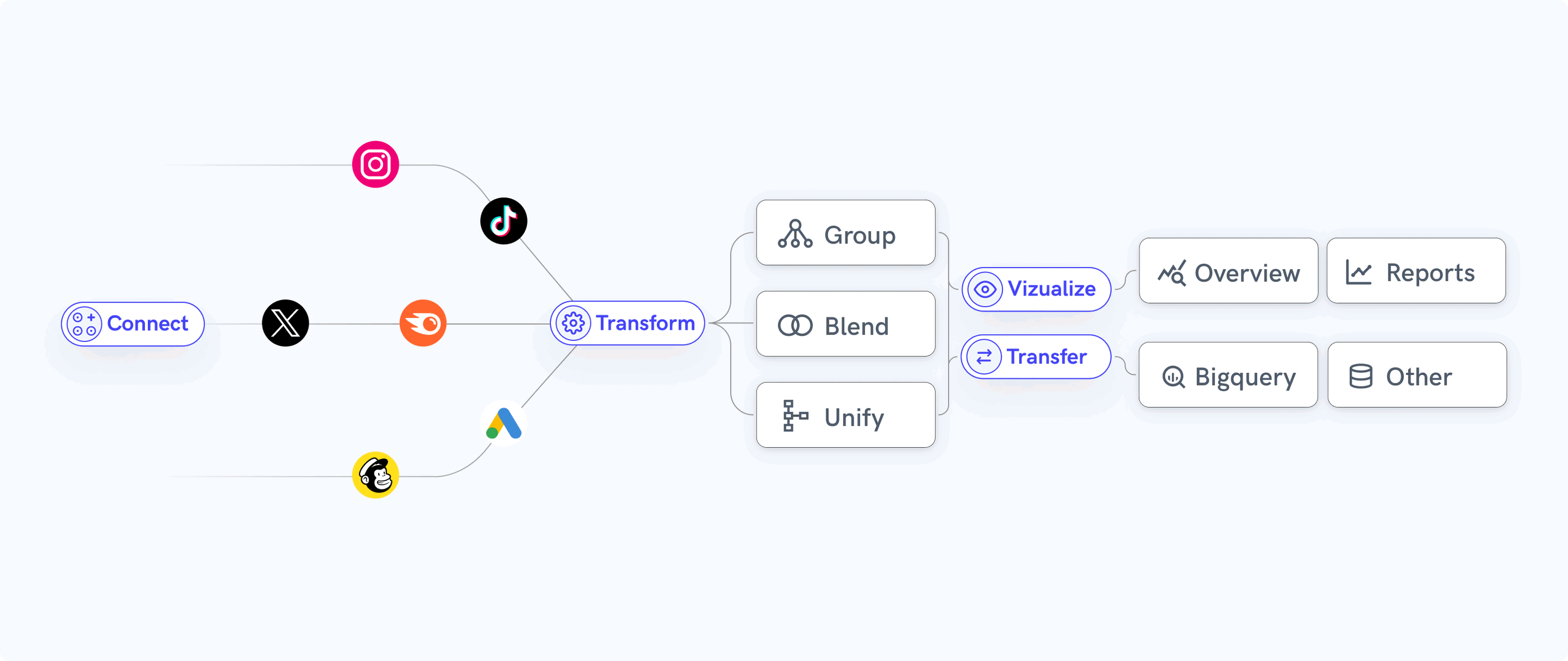
Plus, all our pricing plans come with a dedicated Customer Success Manager and live chat support. Our amazing Customer Support team responds to chats within 4 minutes.
But how does Whatagraph compare against TapClicks exactly? Let’s take a look:
TapClicks vs. Whatagraph: Head-to-Head Comparison
Our Product team did extensive research on how Whatagraph compares against TapClicks and you can find the full breakdown here.
In a nutshell, here are five key ways Whatagraph outperforms TapClicks:
1. Stable, reliable, and accurate platform
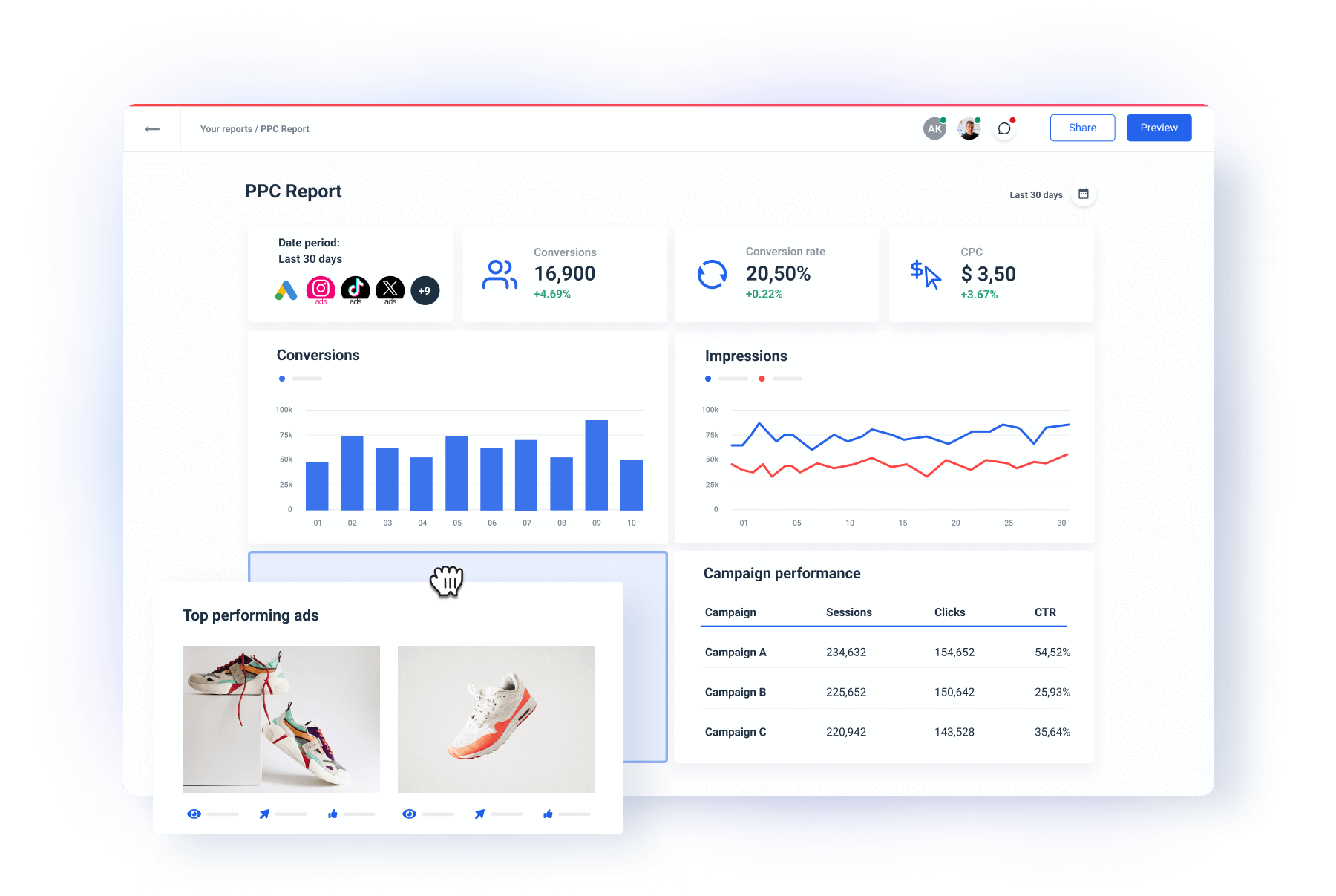 Stability is non-negotiable when it comes to a marketing reporting tool. The last thing you want is to open up a report 30 minutes before a client meeting and see broken connections.
Stability is non-negotiable when it comes to a marketing reporting tool. The last thing you want is to open up a report 30 minutes before a client meeting and see broken connections.
Unfortunately, that’s what TapClicks users experience. Many users online say connections “break all the time”, with one even saying they "hated every aspect of working with TapClicks" because of it.
 Users also say the platform shows inaccurate data on reports and they need to spend “a significant amount of time” troubleshooting.
Users also say the platform shows inaccurate data on reports and they need to spend “a significant amount of time” troubleshooting.
 Whatagraph eliminates these pain points. Here’s how:
Whatagraph eliminates these pain points. Here’s how:
✅ Our data integrations are fully-managed, meaning they’re seamless, stable, and reliable. Our product team regularly maintains them so you don’t have to.
✅ If there are bugs, we can resolve them fast without having to get a third-party company involved.
✅ Your data refreshes every 30 minutes across all your sources, reports, and blends, meaning there are no inaccuracies on reports.
✅ Whatagraph has an average uptime of 99.95% (according to internal data from the past 6 months). This means you don’t have to worry about system outages.
✅ In terms of speed, you can work with 10 sources and 100 widgets at the same time on Whatagraph without slowing down the platform.
Our users love how seamless, stable, and simple the data connection process is. Here’s what one of them said on G2.com:
 2. Easier and faster to build visualizations
2. Easier and faster to build visualizations
Creating a visualization on TapClicks means working with three separate workspaces:
- Dashboards
- Widgets
- Reports
You’ll need to configure settings and styles for each workspace, which is not only time-consuming but also mentally draining.
In fact, building a report involves a whopping 66-step process (as seen on TapClicks’ Help Center) that can take anywhere from 30 minutes to 2 hours.
Widgets are further segmented into “Data,” “Media,” and “Admin” categories, each requiring individual setup. Plus, the clunky, unintuitive interface doesn’t help, as shown in this Media widget example:
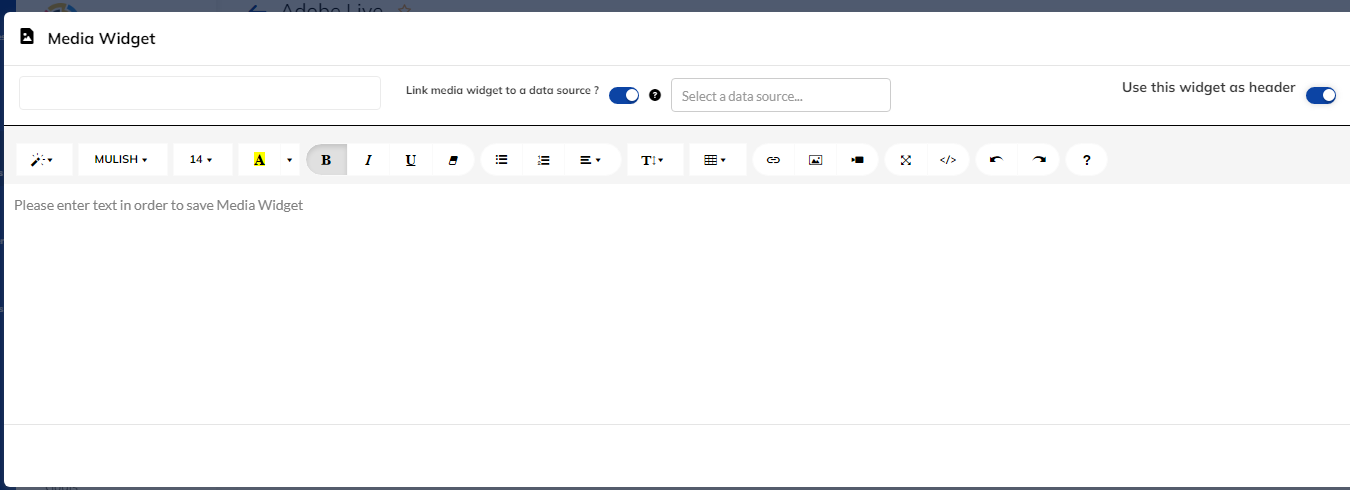 In fact, users report that the initial setup can be overwhelming, and can take up to 6 months. Even then, your reports might still show inaccurate data.
In fact, users report that the initial setup can be overwhelming, and can take up to 6 months. Even then, your reports might still show inaccurate data.
Your marketing dashboard should reduce your cognitive load, not add to it. This is why we built Whatagraph to be incredibly simple and easy to use.
Anyone from your team—whether that’s an Account Manager or an intern—can easily log into Whatagraph and start using it right away.
You create ONE dashboard and that doubles down as a report. And you can add widgets inside the report as you go.
Building your first report is as easy as 1-2-3. You can either:
- Start from a blank page and use our drag-and-drop widgets to add metrics onto the dashboard.
- Use one of our ready-made report templates or dashboard examples.
- Use our Smart Builder to instantly create dashboards for your favorite marketing channels (e.g. Google Analytics 4, Google Ads).
This video breaks it down in detail:
When it comes to adding metrics, you can do so in 5 different ways:
- Build your own metrics and drag-and-drop them onto the dashboard
- Drag-and-drop pre-made metrics onto the dashboard
- Widget templates
- Offline data
- Use Smart Builder
For new users, we always recommend starting from pre-made widgets, which makes life easier and is much faster. You don’t need to write any codes or work with any spreadsheets — just drag and drop on your dashboard and that’s it.
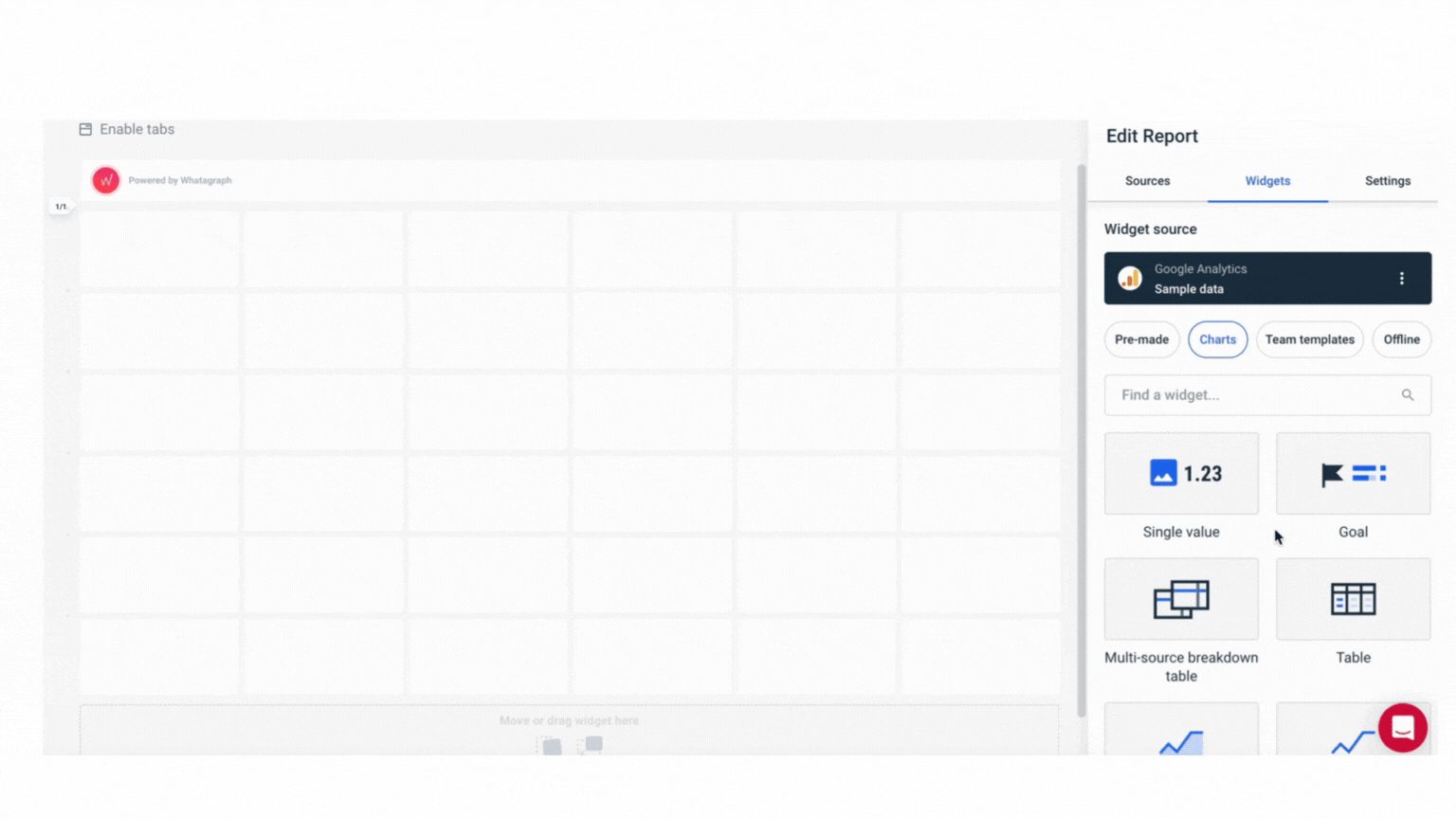 But just because they’re pre-made, doesn’t mean they’re not customizable. You can still:
But just because they’re pre-made, doesn’t mean they’re not customizable. You can still:
- Adjust or rename the metric
- Change or remove icons
- Apply custom formulas (e.g. data blends)
- Change date ranges
- Change currencies
- Add or hide footers
- Customize the colors of each widget
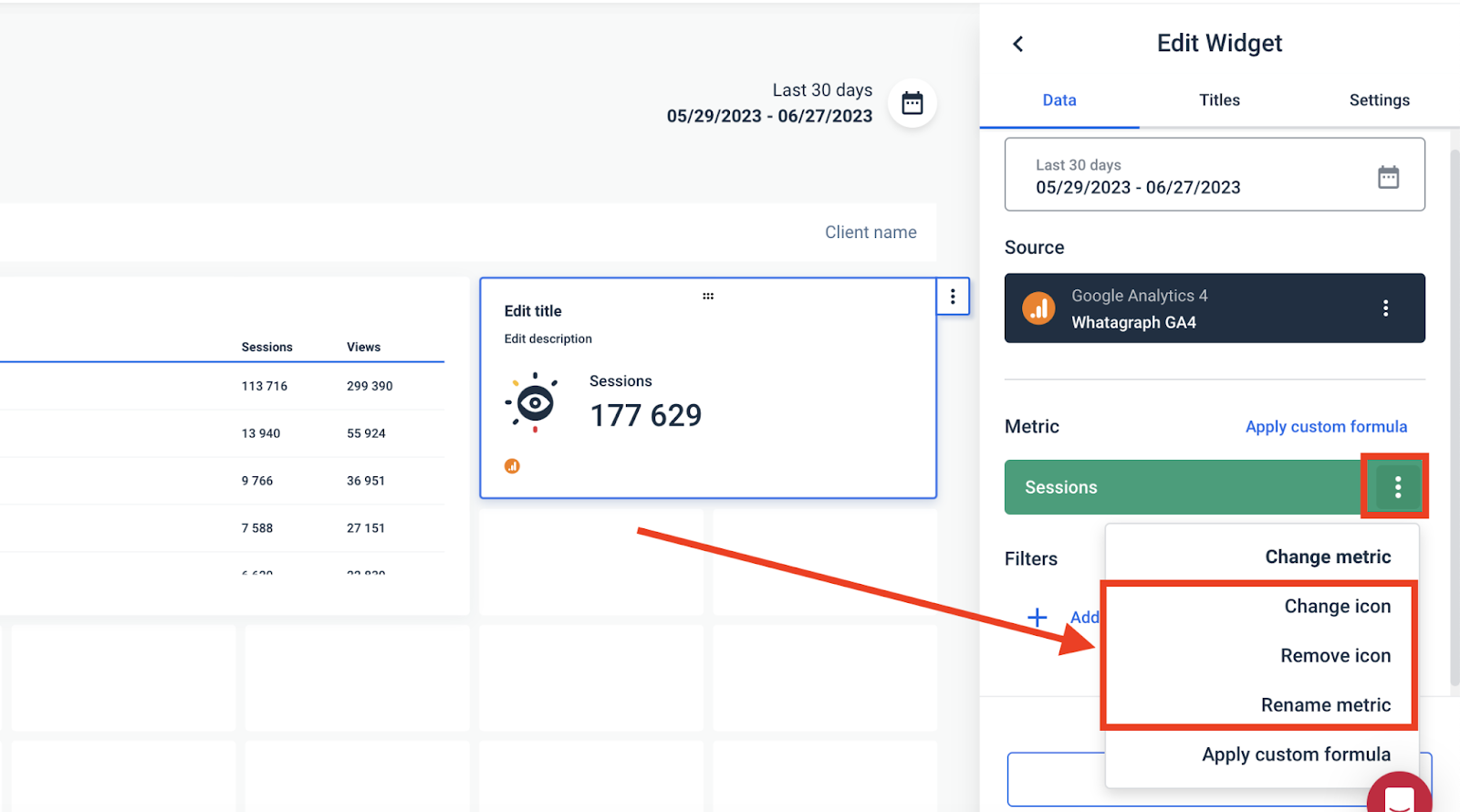 If that’s not enough, you can also create custom widgets and save them as “templates” to re-use them the next time. These widgets are also fully-responsive. You can resize them however you want—horizontally and vertically.
If that’s not enough, you can also create custom widgets and save them as “templates” to re-use them the next time. These widgets are also fully-responsive. You can resize them however you want—horizontally and vertically.
Want to make your widgets “pop” more? You can add any icons you’d like from our icon library:
![]() Whatagraph also comes with thoughtful design features that make your user experience smooth as butter. You can:
Whatagraph also comes with thoughtful design features that make your user experience smooth as butter. You can:
✅ Link reports together and edit in bulk (instead of one by one)
✅ Add different “tabs” to one report to show performance for each channel or campaign
✅ Insert or delete rows anywhere on your report
✅ Change your report orientation as Portrait or Landscape
We covered a lot of customization options but these are just the tip of the iceberg of what you can do with Whatagraph. If you’d like to learn more, book a call with us and we’ll show you exactly how we can help.
Thanks to this simple and intuitive interface, “Ease of use” is our biggest pro on G2.com, and one user raved:
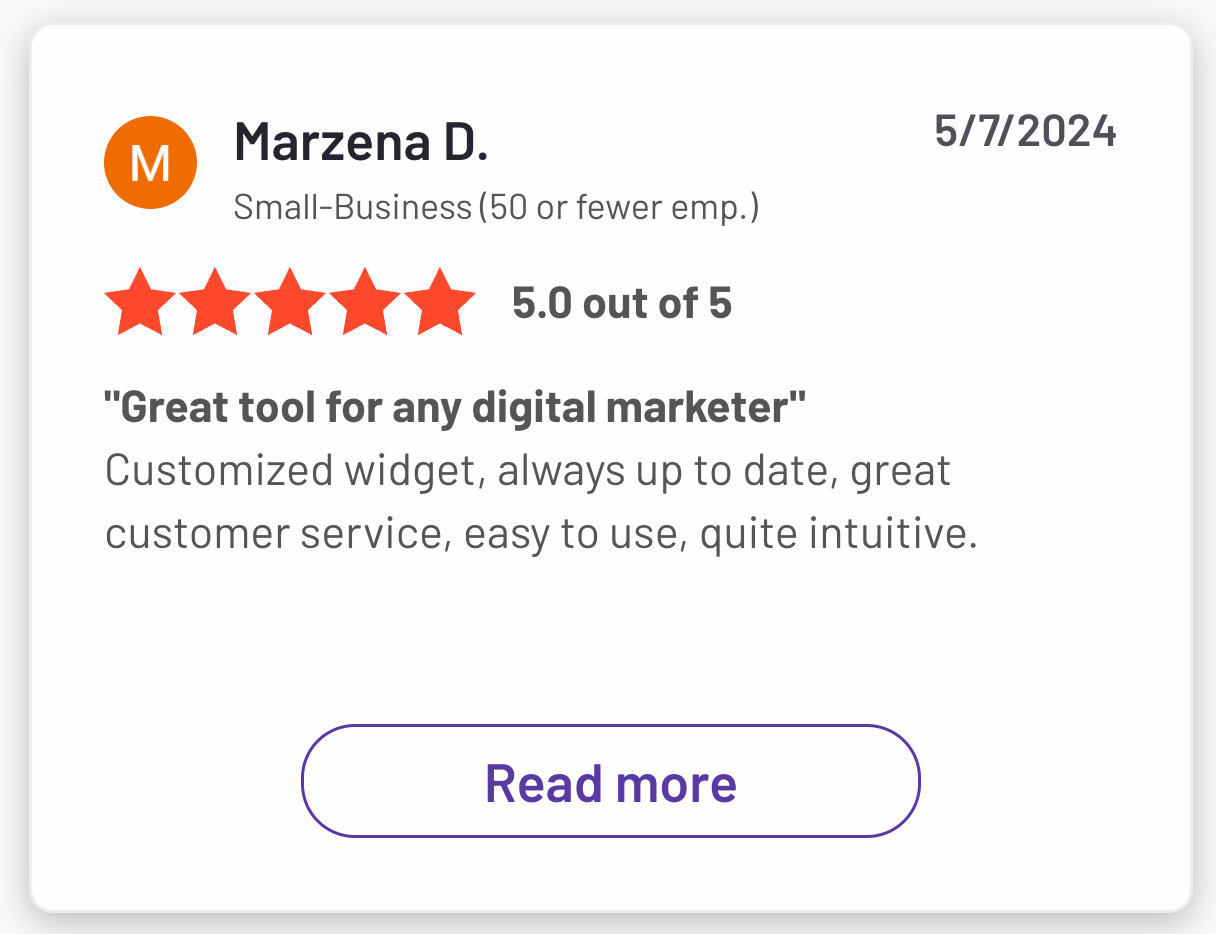 3. Clean, sleek white-labeled reports
3. Clean, sleek white-labeled reports
Whether you’re reporting to clients or the C-Suite, the easiest way to impress them is to send a clean, sleek, and branded report.
But while TapClicks’ reports look like glorified Word documents, Whatagraph’s reports are clean, sleek, and easy to read. Here’s a comparison of the two:
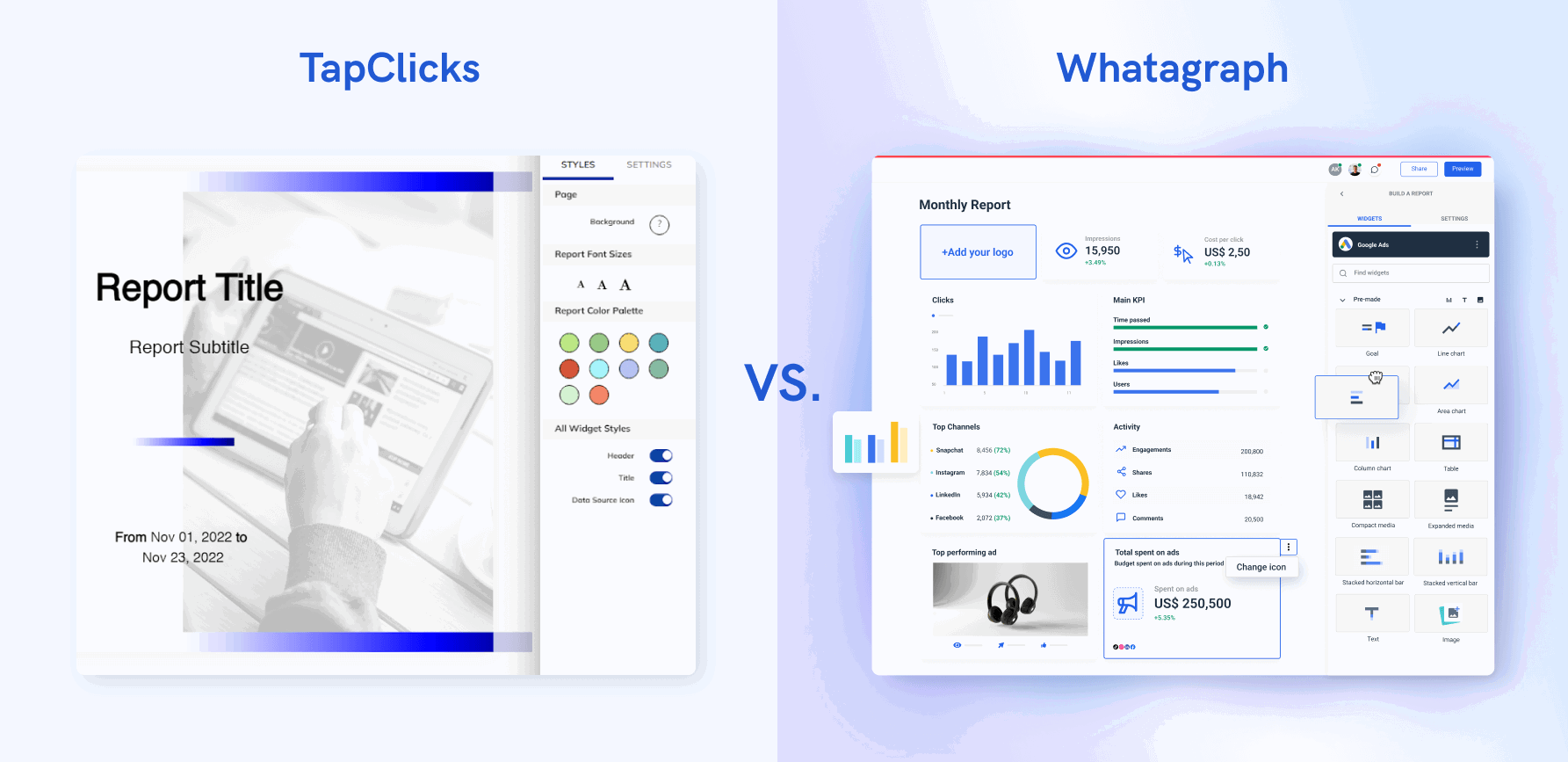 White-labeling is also easy on Whatagraph. You can simply go to “Settings” and:
White-labeling is also easy on Whatagraph. You can simply go to “Settings” and:
- Upload your logo or your client’s logo
- Create custom color schemes
- Add footer and header texts
- Create custom domains to host and share your reports
This video breaks it down:
These custom features will then be applied across all your reports and dashboards, saving you massive time. In contrast, on TapClicks, you’ll need to create a dashboard, then create a report for the same data.
When the time comes for sharing these reports, you can either:
- Send automated emails to specific people at specific times, days, and cadence. Customize the email subject lines, body copy, and even domains.
- Send instant live links to anyone.
- Download PDFs or Excel spreadsheets.
Apart from report sharing, Whatagraph also streamlines data transfers to BigQuery or Looker Studio.
Previously, data transfers used to be complicated with a lot of coding involved.
With Whatagraph, all you need to do is pick metrics and dimensions you want to transfer, preview your future table, and start an automated transfer.
This reduces the time and workload of having to manually prepare data to send to destinations.
4. Powerful (but easy) data organization features
If you have 100s of scattered data across different sources, marketing campaigns, channels, and accounts, you need a way to organize them all into unified metrics and dimensions before you visualize the data.
This helps you get a clearer view of performance and keeps your reports neat, tidy, and easy to read.
On Whatagraph, you can easily organize your data by:
- Blending data sources together
- Creating custom metrics
- Creating custom dimensions
…all through simple workflows that only take seconds to set up.
For instance, say you want to blend data from Google Analytics 4 and Google Ads. All you need to do is:
- Choose the dimensions and metrics you wish to use inside the blend.
- Select the join type.
- Give it a name and description.
And you’ll be able to use the new blended source inside your report right away.
 Or say you want to standardize your metric names between Google Analytics 4 and Facebook page. You can easily create a custom metric like so:
Or say you want to standardize your metric names between Google Analytics 4 and Facebook page. You can easily create a custom metric like so:
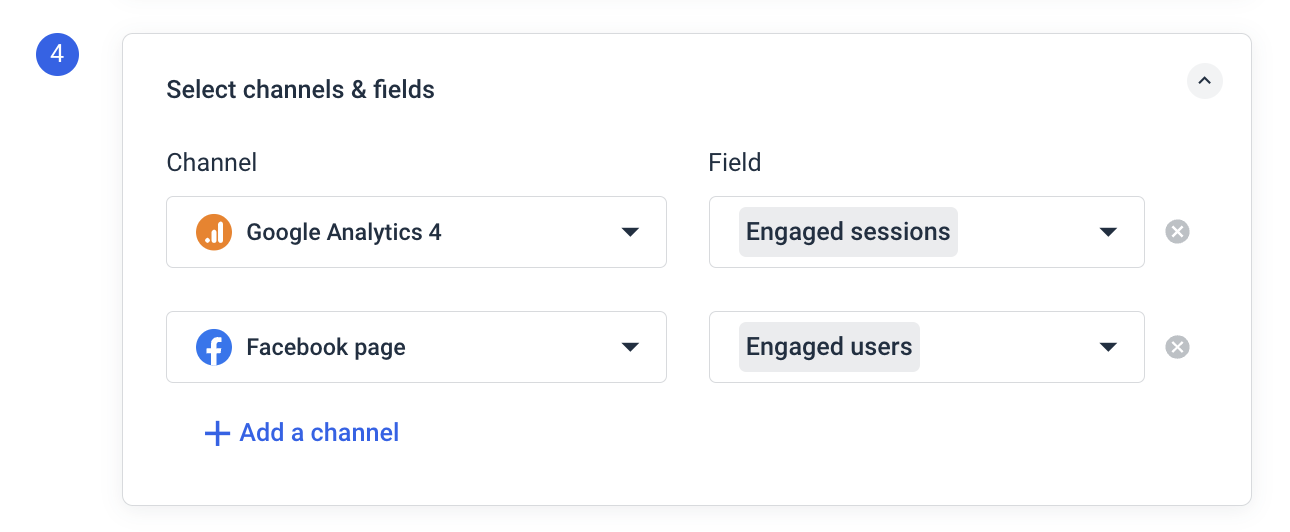 The best part is you can do all these natively inside of your report. No need to waste time going back and forth from one workspace to another.
The best part is you can do all these natively inside of your report. No need to waste time going back and forth from one workspace to another.
We also recently launched Performance Monitoring, which makes it even easier and faster to organize your scattered data and get actionable insights from it.
You can:
- Group 100s of scattered data sources into unified Source Groups in seconds
- Add custom tags to your data and filter it by client, business type, location, Account Manager, or whatever floats your boat
- Visualize and monitor your key metrics in one spot
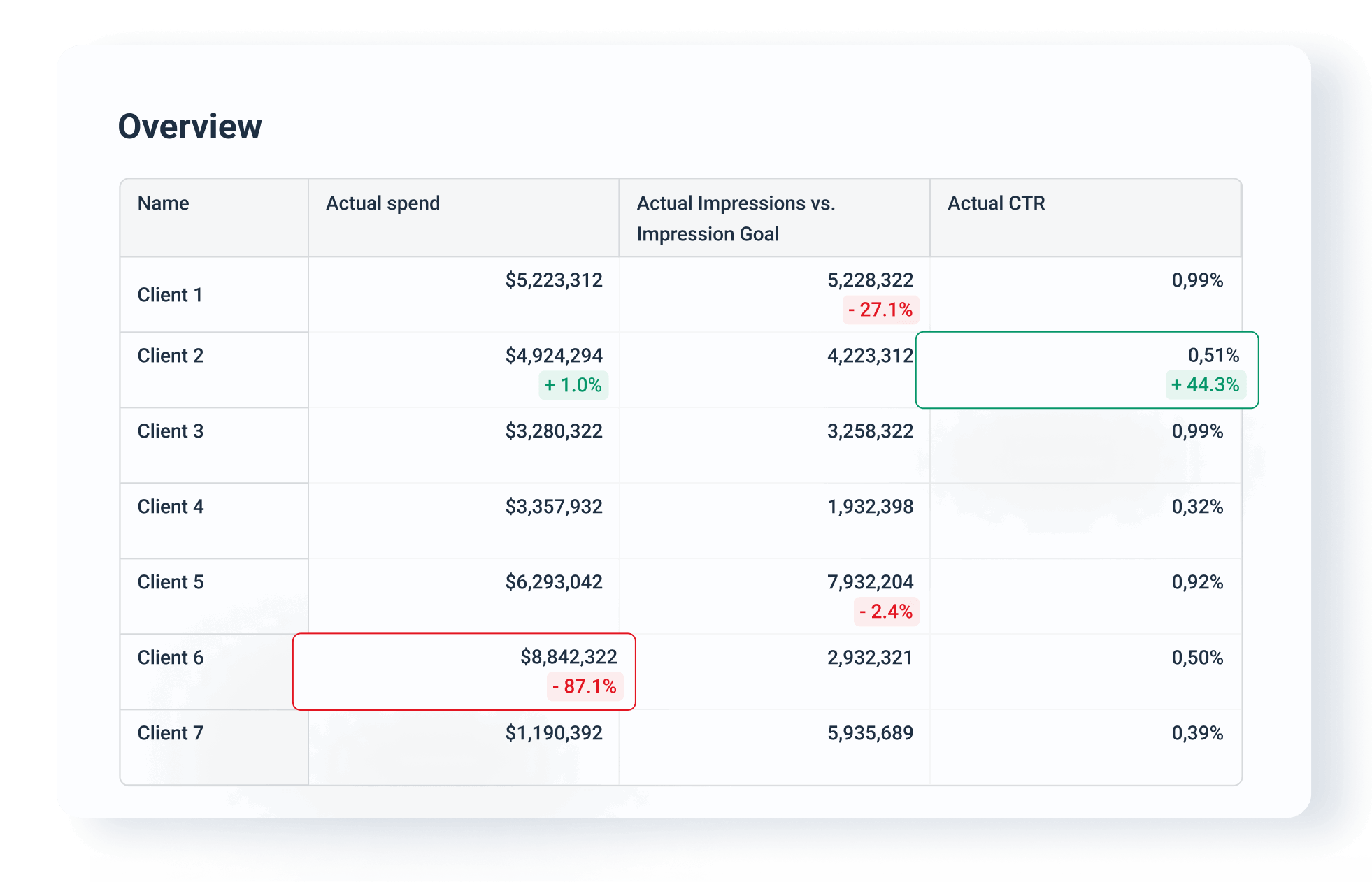
5. Straightforward pricing with Customer Success and Support
TapClicks offers many different tools and each of them has a pricing plan of its own.
For marketing reporting, you start by choosing how many data connectors you need:
- TapDataLite: $99/month for 64 connectors
- TapData+: $349/month for 250+ connectors
- TapData Max: $649/month for 250+ connectors and API access
Then, you choose your data destination:
- TapReports: $199/month
- TapAnalytics: $899/month
- TapInsights: $1399/month
- Third-party destinations: Custom pricing
Based on these pricing plans, the total cost of TapClicks can come down to 1000s of dollars a month if you want a complete data stack.
It’s also unclear whether these plans come with customer support or a dedicated Customer Success Manager.
In comparison, Whatagraph’s pricing is straightforward.
We offer three pricing plans based on the amount of “source credits” and access to customization and data organization capabilities.
You can use source credits to connect data sources, send data from a source to a warehouse, and blend cross-channel data together.
ALL our pricing plans come with:
✅ 55+ fully-managed integrations
✅ Custom integrations via APIs, Google Sheets, and BigQuery
✅ Unlimited dashboards and reports
✅ A consistent data refresh rate of 30 mins
✅ Data transfer to BigQuery and Looker Studio
✅ Dedicated Customer Success Manager
✅ Fast customer support (<1 min first response time) via live chat and email
Convinced Whatagraph is the right TapClicks alternative for you? Book a call and tell us exactly how we can help.
Key Features
- 55+ native integrations
- Custom integrations through Custom API, Google Sheets, or BigQuery
- Versatile drag-and-drop widgets for reports and dashboards
- Custom metrics, dimensions, and data blends
- Currency conversions
- Library of pre-made dashboard and report templates
- Export to Excel and CSV
- AI insights
- Custom branding and white-label features
- Automated report sharing via email
- Links to live dashboards
- No-code data transfer to BigQuery and Looker Studio
Whatagraph Reviews from Real Users
“To me, Whatagraph is like the Tesla or Mercedes of digital analytics tools, their clean and simple way to present complex marketing data. I highly recommend it to anyone working with marketing analytics who values efficiency and clarity in their reporting.” (Source)
“Whatagraph has a simple user interface that is easy to navigate even for those who don't have analytical skills.” (Source)
“What I like best about Whatagraph is having the ability to create reports fast and easy. No more spreadsheets to do reports, they have a great variety of templates.” (Source)
Pros and Cons
Pros:
- All-in-one marketing performance monitoring and reporting solution
- Easy to use by anyone on your team
- Fast campaign performance and insights
- Stunning visual reports
- Makes results easy to interpret
- Excellent live chat customer support
Cons:
- No freemium plan
- Can be expensive for small agencies (under 10 employees) and freelancers
2. Tableau
Most suitable for: Data teams at large enterprises
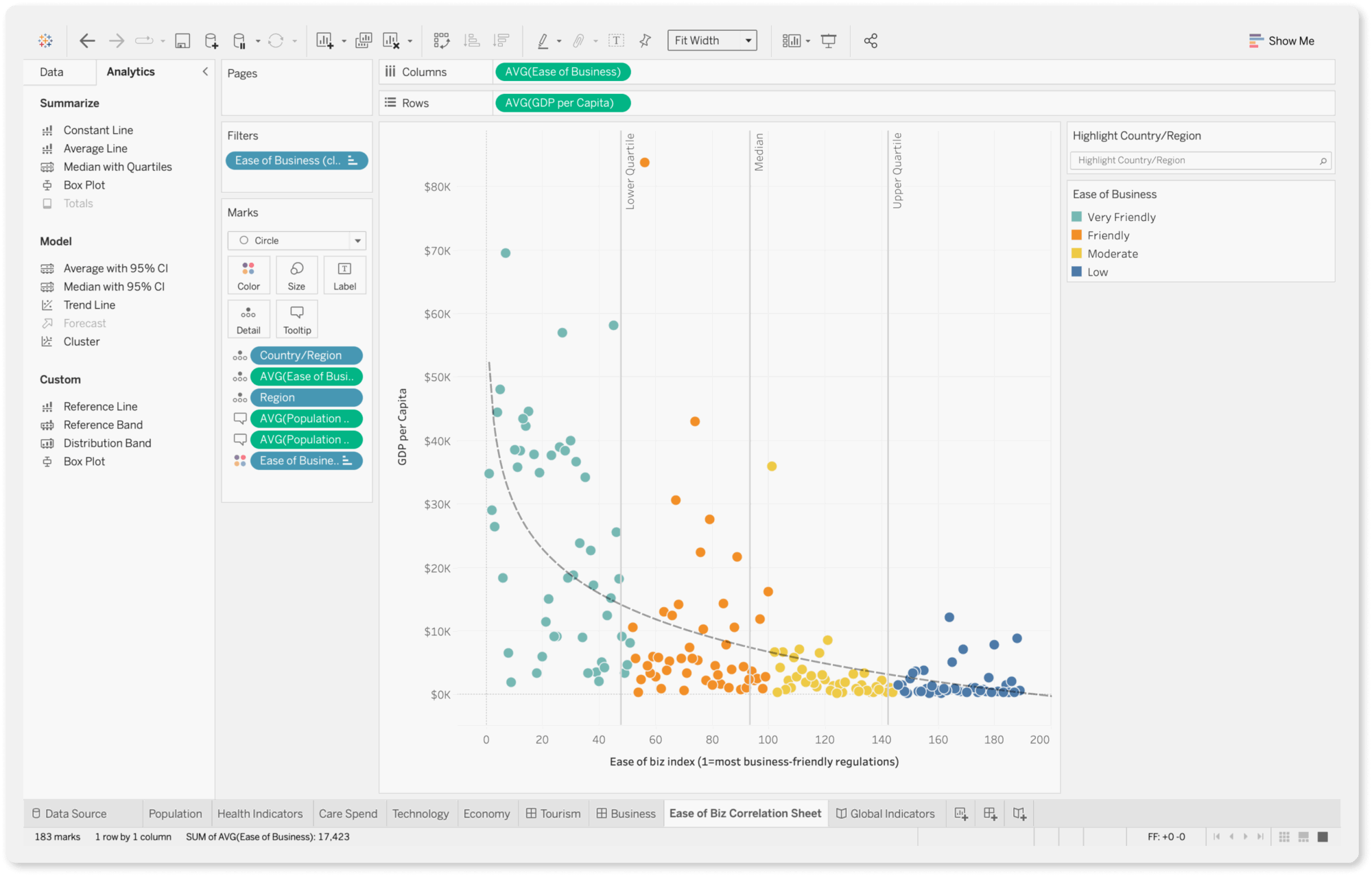 If you’re ready to invest in an enterprise-level business intelligence solution, Tableau is a great choice.
If you’re ready to invest in an enterprise-level business intelligence solution, Tableau is a great choice.
For a powerful data analysis tool, Tableau is easy to use with a drag-and-drop interface and visual query builder. You can generate insights quickly and share them with stakeholders through reports.
Compared to TapClicks, Tableau’s charting and data exploration features are more sophisticated, including support for advanced calculations, statistical functions, and predictive modeling.
You can perform complex data analysis, uncover trends, and identify opportunities for optimization using features such as trend lines, forecasting, and clustering.
What’s more Tableau boasts quite a large and active user community called “Tableau Community Forums” with a wealth of resources, forums, and online training materials to help you learn the platform and troubleshoot issues.
You can also purchase “Success Plans” that come with personalized training and support.
However, Tableau can be pricier than TapClicks as it’s a tool made for enterprises.
Key Features
- 90+ integrations
- Custom metrics and dimensions
- Data blending
- Drag-and-drop dashboard interface
- AI-powered insights
Tableau Reviews from Real Users
“Tableau allows me to create my own structured data from a lot of unstructured data.” (Source)
Tableau has an uncanny ability to transform complex data into visually stunning and easily understandable representations.” (Source)
“Tableau can be costly, particularly for startups.” (Source)
Pros and Cons
Pros:
- Powerful data analytics and visualization
- Easy to use and implement
- Seamless data integrations
Cons:
- Can be expensive if you need advanced features
- Takes a lot of time to load for large datasets
- All the preprocessing of the data (data cleaning) has to be done beforehand. Data cleaning cannot be done in Tableau
Tableau Pricing
As of October 2024, Tableau offers three pricing plans:
- Viewer: $35/user/month, billed annually
- Explorer: $70/user/month, billed annually
- Creator: $115/user/month, billed annually
3. Geckoboard
Most suitable for: Medium to large businesses in the Customer Service, Sales, and eCommerce sectors
Geckoboard is an easy to use dashboard software mostly targeting Customer Service, Sales, and eCommerce businesses.
With it, you can connect to 90 data sources, design your dashboard, and share the dashboard with your team members or the C-Suite.
Once your data is connected, you can create three main types of dashboards:
- A blank dashboard
- TV dashboards for internal presentations
- Mobile dashboards
- Snapshots and reports
Then, you can send snapshots of these dashboards via Slack and email to stakeholders on a regular basis. TapClicks does not come with a Slack integration.
However, unlike Whatagraph, you won’t be able to create custom data blends, metrics, and dimensions on Geckoboard. This can be a deal breaker if you’re a large company and you need to organize your scattered data to create easy to read and impactful reports.
Key Features
- 90+ integrations with Customer Service, Sales, Finance, and eCommerce channels
- Drag-and-drop dashboard builder
- KPI notifications
- Slack integration
- Automated email reports
- TV dashboards
- Mobile-friendly dashboards
- Dashboard examples for businesses
Geckoboard Reviews from Real Users
“I love how simple it is to use. That you can connect data from so many different sources in an easy way.” (Source)
“Connecting the dashboard with the Tv works like a charm.” (Source)
“Geckoboard could use more features and options for customization. Compared to other tools like Power BI or Tableau, Geckoboard didn't have as many advanced tools for analyzing data or changing how things looked. I wished I could make more complicated charts and do special calculations.” (Source)
Pros and Cons
Pros:
- Easy to use and set up
- A wide variety of integrations
- Great customer service
Cons:
- Can be pricey if you want to add more dashboards
- Limited customization options for dashboards
- No advanced calculations, blends, and custom metrics and dimensions supported
Geckoboard Pricing
Geckoboard’s pricing is based on the number of dashboards. But unlike DashThis (which includes unlimited users), Geckoboard has limitations on the number of users.
As of October 2024, Geckoboard offers three pricing plans:
- Essential: $149/month for 5 dashboards, 3 users, 1 TV share, and core data sources
- Pro: $199/month for 5 dashboards, 10 users, 3 TV shares, and pro data sources
- Scale: $699/month for 30 dashboards, 25 users, 10 TV shares, pro data sources, and dedicated Support rep
4. Looker Studio (a.k.a. Google Data Studio)
Most suitable for: Freelancers and boutique agencies
Only need integrations with Google platforms? Looker Studio is a great choice.
Looker Studio is a (sort of) free client reporting tool that comes with 21 native integrations with Google-based platforms like Google Ads, DV 360, Google Sheets, and Google Analytics. You can also connect to BigQuery, MySQL, and Microsoft SQL servers on Looker.
Once your data sources are connected, you can use Looker’s drag-and-drop report editor to ad:
- Charts, line bars, pie charts, geo maps, area and bubble graphs, data tables, pivot tables
- Filters and date range controls
- Links and clickable images
- Custom text and images
- Custom styles and color themes
You can then invite teams or clients to view or edit your reports, or send them links in scheduled emails.
Compared to TapClicks, Looker Studio is a no-frill tool that gets the core job—reporting—done. It’s also a more cost-effective option if you only need Google-based platforms.
However, fair warning that Looker Studio can be slow and prone to data inconsistencies.
Key Features
- 21 native connectors (free)
- 1000+ “partner” connectors (paid)
- Drag-and-drop report builder
- Data blends
- Custom images and text
- Custom styles and color schemes
- Mobile app
Looker Studio Reviews from Real Users
“I love the way you can present data from multiple sources in one report. I also love the ability to blend different tables and show the information in one chart.” (Source)
“Unfortunately, connectors break quite regularly and reports containing a lot of data can take a lengthy time to load.” (Source)
“Looker studio needs more report downloading options such as Word and PDF.” (Source)
Pros and Cons
Pros:
- Free (to an extent)
- A huge range of data visualization formats and options
- Easy to use for basic reports
Cons:
- Slow loading
- Connection breakages and inaccurate data
- Limited report sharing options (no Word, Sheets, or PDFs)
Looker Studio Pricing
Looker Studio is free for connections with 21 native integrations, which are mostly Google-based platforms.
5. AgencyAnalytics
Most suitable for: SEO and content marketing agencies
AgencyAnalytics is an easy to use marketing reporting platform great for SEO and content marketing agencies.
You can connect to 80+ data sources, including major SEO platforms like Ahrefs, Backlink Monitor, and Semrush, as well as social channels like Facebook, Instagram, and LinkedIn.
It comes with a suite of SEO tools like Rank Tracker, Site Auditor, and Backlink Manager, making it easy to monitor and report on your SEO performance. You can track rankings daily, monitor backlinks, and keep up with the competition.
You can also manage clients and staff on the platform through granular user access and permissions.
AgencyAnalytics’ key advantage over TapClicks is their simple and clean user interface. Similar to Whatagraph, you’ll just need to create one report instead of having to navigate different workspaces.
However, users say the platform can be unstable with sources disconnecting frequently due to “service bandwidth” issues. AgencyAnalytics also doesn’t come with advanced data calculations and their dashboards are rigid and limited.
Key Features
- 80+ integrations
- Ready-made report templates
- White-labeling
- Client and staff management
- SEO tools
- AI insights
AgencyAnalytics Reviews from Real Users
“AgencyAnalytics helps me create quick, automated, and clean reports for our clients which saves me a ton of time.” (Source)
“It can sometimes be a little buggy and take time to load. Adding new integrations can sometimes be challenging because of this.” (Source)
“I would like the capability of merging data from different platforms in graphs and metrics (e.g. using data from Google Ads with GA4) in the same section. I also don't like that some platforms aren't yet available (e.g. Reddit).” (Source)
Pros and Cons
Pros:
- Easy to set up and use
- A wide library of ready-made report templates
- Cost-effective
Cons:
- Buggy
- Lack of advanced data calculations and organization features
- Limited integrations
AgencyAnalytics Pricing
As of October 2024, AgencyAnalytics offers three plans:
- Freelancer: $79/month for 5 client campaigns
- Agency: $179/month for 10 client campaigns
- Custom: For established agencies with 50+ clients
6. Swydo
Most suitable for: Small PPC or digital marketing agencies
Swydo is an automated monitoring and reporting platform for marketers. Here are three key aspects of the platform:
- Data collection:Integrate with 32+ platforms and combine your data into one comprehensive report. These integrations include popular channels like Google Ads, Facebook Ads, and Google Sheets.
- Reporting: Create reports easily using templates and their library of metrics and pre-set widgets. Or, add your own customized widgets. Share custom reports as PDF, dashboards, or live presentation.
- Monitoring: Monitor client or stakeholders’ KPIs to quickly identify and address issues and opportunities. Sywdo comes with KPI boards, clients KPI overviews, and alert notifications.
Swydo’s key advantage over TapClicks is their ease of use. The platform is very simple and easy to navigate, unlike TapClicks’ overcomplicated UX/UI.
However, Swydo can also be very limiting. Apart from a basic “Custom metric” builder, you can’t blend data sources or create custom dimensions on Swydo. This can lead to messy reports with inaccurate data and inconsistent dimensions.
Swydo is also purely a reporting tool—you won’t be able to ship your data to data warehouses or business intelligence platforms.
Key Features
- 32+ native integrations
- Custom Google Sheets integration
- Custom metric builder
- KPI Monitoring dashboard
- Data filters and markups
- Alerts when KPIs trend up or down
Swydo Reviews from Real Users
“I love that you can customize it as you want, and for social media, you have the little images of the posts next to the results.” (Source)
“Easy to use. The ability to use pre-set templates for each of our products is perfect. Their customer service is also fantastic.” (Source)
“You don't have as much control over how the widgets are displayed on the page. Limited theme and branding capabilities.” (Source)
Pros and Cons
Pros:
- Easy to use and set up
- A wide range of reporting templates for quick-start
- Responsive customer support
Cons:
- Limited data integrations
- Unstable data connections
- No advanced data transformations available
Swydo Pricing
Swydo’s pricing is based on the number of data sources. As of November 2024, the pricing looks like this:
- First 10 data sources: included in initial monthly base fee $49
- 11 - 100 data sources: $3.50 per data source
- 101 - 500 data sources: $2.50 per data source
- 501+ data sources: $1.50 per data source
For example, if you need 100 data sources, expect to pay around $364/month. It’s unclear, however, whether this pricing includes Customer Support and a Customer Success Manager, or if these are extra.
7. Databox
Most suitable for: Boutique agencies and small businesses
Databox is a data reporting and analytics platform for growing businesses.
You can integrate with 100+ software tools, and bring in custom data through Google Sheets or Excel. Then, you can visualize this data directly on Databox using pre-built metrics and templates.
A unique feature that Databox offers that TapClicks doesn’t is the Benchmark Groups. You can browse industry benchmarks to gauge whether you’re doing well, better than others, or falling behind.
Databox also sends alerts through Slack, email, or app updates when performance trends up or down on your tracked metrics. On TapClicks, this is only possible through emails.
However, Databox users say the platform is clunky and difficult to use.
Databox’s reports are also not linked – which means you’ll need to edit them one by one rather than in batch. This can be very time-consuming if you need to tweak dozens of similar reports for clients. On Whatagraph, you can edit them in one-go, saving you massive time.
Key Features
- 100+ integrations
- Native visualization dashboards and reports
- Dashboard and report templates
- Slack, email, or in-app alerts
- KPI benchmark groups
Databox Reviews from Real Users
“Databox makes it simple to interact with data in ways you never thought possible.” (Source)
“I'm not sure what has happened with the customer support team at Databox but they are fairly unresponsive these days.” (Source)
"After 2 years I left. Templates always break, individual metrics always break, lack of good support." (Source)
Pros and Cons
Pros:
- Easy to use
- Wide variety of integrations
- Interactive data
Cons:
- Slow customer support
- Bugs and lag issues
- Broken metrics and templates
Databox Pricing
Databox offers five different pricing plans as of October 2024:
- Free: Limited to 3 users, data sources, and dashboards. No custom metrics, data calculations, or report automation available.
- Starter: $341/month for 50 data sources, 5 users, and unlimited dashboards.
- Professional: $451/month for 50 data sources, 15 users, and unlimited dashboards. Includes custom metrics and data calculations.
- Growth: $681/month for 50 data sources, and unlimited users and dashboards.
- Premium: $999/month for 100 data sources, and unlimited users and dashboards.
White-labeling and “guided onboarding” is also only available as an add-on on Databox ($250 and $500 per month respectively). In contrast, these are included in all of Whatagraph’s pricing plans.
8. DashThis
Most suitable for: Small businesses and freelancers
DashThis is a simple reporting tool catering to small businesses. You can integrate with 34+ platforms.
If you don’t see a built-in integration you need, you can also upload your own data using a nifty CSV file or a Google Sheet. In comparison, Swydo only offers Google Sheet integration.
Once your data is connected, you can visualize it using three key dashboards:
- Periodic dashboards: These are dashboards based on specific time periods and cadence, like daily, weekly, monthly, semi-annually, and annually.
- Campaign dashboards: These dashboards are used to isolate and highlight a specific campaign for a custom date range.
- Rolling dashboards: These dashboards show trends of metrics for three different date ranges.
These dashboards are also pre-made, meaning you can quickly get started.
On the more pricier plans, you’ll get a dedicated product specialist assigned to you who will help you set up your dashboards.
However, DashThis is more suitable as a reporting tool rather than a data analytics platform. There are very few options to customize or organize your data on DashThis.
You can only “merge” widgets together in DashThis; you can’t blend data sources to the full extent or create advanced metrics and dimensions. On Whatagraph, you can easily organize your data any way you’d like using simple workflows.
Key Features
- 30+ integrations
- Custom data upload via CSV file or Google sheets
- Visualization dashboards
- Automatic data refreshes
- Upload client or band logos
- Create custom widgets, domains, color schemes, and email addresses
- Library of report templates
- Report sharing via email, URL, or PDF
DashThis Reviews from Real Users
“DashThis is super user friendly. I am someone who doesn't know too much about Data Dashboards, but this platform was super easy to use.” (Source)
“There are some limitations to what you can bring in and they don't yet offer custom calculations.” (Source)
“It is a little annoying to move things around in a dashboard. You have to move each individual widget to a new section rather than moving an entire section in a dashboard.” (Source)
Pros and Cons
Pros:
- Easy to use and set up
- Many templates and dashboard examples available
- Relatively inexpensive
Cons:
- Limited data organization and customization features
- Limited data integrations
- Basic-looking reports
DashThis Pricing
As of October 2024, DashThis offers four pricing plans:
- Individual: $49/mo or $42/mo, paid yearly. Includes 3 dashboards. No white-labeling features, personalized onboarding, or priority support.
- Professional: $149/mo or $127/mo, paid yearly. Includes 10 dashboards. No personalized onboarding or priority support.
- Business: $289/mo or $246/mo, paid yearly. Includes 25 dashboards, white-labeling, personalized onboarding, and priority support.
- Standard: $449/mo or $382/mo, paid yearly. Includes 50 dashboards, white-labeling, personalized onboarding, and priority support.
9. Grow.com
Most suitable for: Data analysts at medium to large enterprises
Grow is a no-code full-stack business intelligence platform that combines ETL, data warehousing, and visualizations on one platform.
You can connect to 75 data sources through native integrations, including popular CRM platforms, marketing analytics tools, databases, and accounting software.
Then, you can prepare and cleanse your data using either noSQL or SQL transformations. This includes custom calculations, data blends, and advanced data filters.
Plus, Grow stores your data automatically on its platform so you don’t need to ship it to a third-party data warehouse. TapClicks does not have this native storage layer.
You can create three types of dashboards on Grow:
- Dynamic dashboards which display data based on who is logged into the account.
- Dashboard Blueprints which are pre-built, single data source dashboards
- Custom & Sandbox dashboards which shows blended data sources and metrics
These dashboards also come with powerful filtering options based on date, number, or categorical logic.
You can then share them through emails, shareable URLs, Slack, TV-mode, or tables of raw and transformed data.
The platform uses APIs to import data seamlessly from data sources, and it continually refreshes the data so your metrics are up-to-date and reliable.
The key advantage of Grow over TapClicks is their 24/7 customer support via live chat. US-based customers can also call their hotline to get quick answers.
However, Grow is more suitable for internal data storage and monitoring rather than for external reports. Their dashboards are very nitty-gritty which can overwhelm clients or the C-Suite.
Key Features
- 75 native integrations
- Built-in data storage
- SQL or non-SQL based data transformations
- Customizable dashboards
- Advanced data analytics and predictive modeling
- Real-time data updates
Grow Reviews from Real Users
“As an analyst, I have recently started working on this tool and this is by far the best. It helps me to create powerful data visualisation as well as to gain insight from that data.” (Source)
“The interface could be better and overall user experience creates lag sometimes.” (Source)
“The back end seems quite complex to work so really need an IT expert to do the set up, but once it's working it's great for users.” (Source)
Pros and Cons
Pros:
- Inuitive, easy to use interface
- 24/7 customer support
- No-code data pipelines, storage, and visualizations
Cons:
- Occasional lags
- Expensive
- Slow performance when dealing with large volumes of data
Grow Pricing
Grow doesn’t share their pricing publicly.
10. NinjaCat
Most suitable for: Marketing agencies and brands with dedicated data scientists
Similar to Whatagraph and Grow, NinjaCat is an end-to-end platform for connecting to your data sources, cleaning the data, visualizing it, and shipping it to destinations.
You can integrate with 100+ pre-built connectors, ranking from CRM, search advertising, web analytics, and project management tools.
You can then simplify and harmonize your data with no-code transformations and custom calculations. There’s also the option to store your data in a managed warehouse. Or, you can ship your data to external storage destinations like Snowflake, BigQuery, or Amazon S3, or business intelligence destinations like Tableau and Looker Studio.
When it comes to creating reports, you can start from a blank template (that looks like a “canvas”) and add and adjust metric widgets as needed.
Key Features
- 100+ pre-built connectors
- No-code transformations and calculations
- Data transfer to BI tools and data warehouses
- Easy ad spend and campaign performance monitoring
- White-label options
- White-glove setup and service
NinjaCat Reviews from Real Users
“I love how it pulls in our data across several different platforms into one cohesive report.” (Source)
“The support the NinjaCat provides is exceptional.” (Source)
“I found a lot of the functionality on Ninjacat to be really clunky, unfortunately things take a LONG time to process if you're adding more than one filter to a table.” (Source)
Pros:
- Automated client reporting
- One platform for integration and visualization
- Multiple choice of destinations
- Custom branded reports
Cons:
- Separate workspaces to organize and visualize data
- Complex visualization builder
- Performance issues with reports
- No autosave in case of a crash
Pricing
NinjaCat doesn’t offer fixed pricing plans, and no information is available on its website.
11. Funnel.io
Most suitable for: Enterprises with dedicated data scientist teams
If you’re looking for a data pipeline tool, Funnel is a great choice. It pulls data from different sources, transforms it, and ships it to data warehouses, visualization tools, or spreadsheets.
Funnel boasts over 500 data connectors with major marketing platforms and CRM systems, such as Hubspot, Salesforce, DV360, and more.
If you don’t see a connector, you can also import your own data using a Google sheet, or request the Funnel team to build one for you.
Funnel does offer a basic visualization dashboard to visualize your key metrics, but there aren’t a lot of customization or white-labeling options available (the company admits that it’s not a “Tableau or Looker Studio killer” yet).
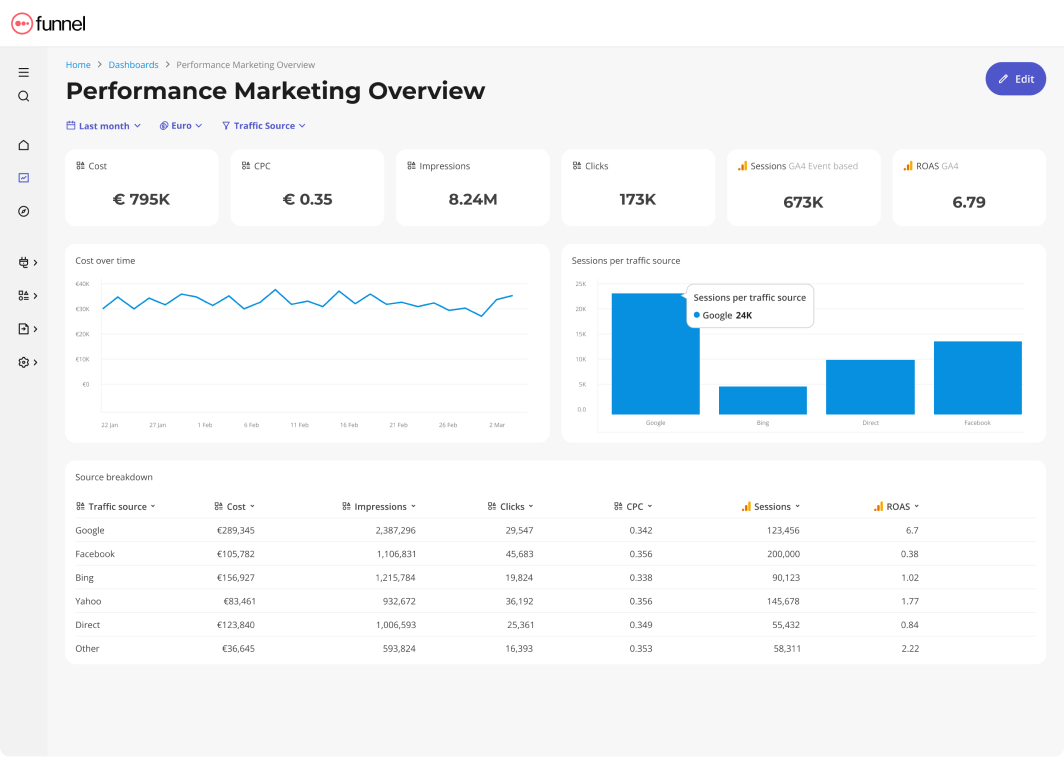
One powerful feature of Funnel is their Marketing Measurement. This lets you find channels and campaigns that drive results easily so you can optimize your media mix with more confidence.
With it, you’ll get AI recommendations on where to increase and decrease spend based on marginal CPA and ROAS to increase budget efficiency. You can also create “what-if” scenarios with just a few clicks to investigate the impact of budget changes for any channel.
However, Funnel is difficult to use and much more expensive than TapClicks.
Key Features
- 500+ integrations
- Custom integrations or Google Sheets data import
- Custom dimensions, metrics, and currency conversions
- “Data Explorer” dashboard for data scientists
- Basic visualization dashboards to view key metrics
- Export to data destinations
Funnel Reviews from Real Users
“Funnel does the work of several people, we now couldn't run our business without it.” (Source)
“What I like most about Funnel is how customizable it is. Within their Data Explorer you can look at the data in any way please and any possible configuration.” (Source)
“Takes some time to wrap your head around, and the set up takes some time. Still some bugs in some connectors that haven't been solved after a few months.” (Source)
Pros and Cons
Pros:
- A wide range of connections with all major marketing platforms
- Low-code data organization interface
- Fast and helpful customer support team
Cons:
- Initial steep learning curve
- Occasional bugs in connectors
- Basic native visualization widgets
Pricing
Funnel.io’s pricing model is based on “flexpoints” which are usage credits to add new data connectors, transform data, and move it to destinations.
It offers three distinct pricing plans: Starter, Business, and Enterprise.
- Starter: $1.2 / flexpoint per month. This plan allows you to connect the first 3-5 sources and use 350 flexpoints* for free. It includes 121 core integrations, 3 Core destinations, and the Data Explorer.
- Business: $1.5 / flexpoint per month. Gives you everything in Starter plus 381 additional Business connectors, 37 Business destinations, data source templates, and unlimited workspaces.
- Enterprise: $2.0 / flexpoint per month. The plan designed for organizations operating at scale includes everything in Business plus 11 Enterprise connectors, 1 additional Enterprise destination (Snowflake), data region choice, and technical account management.
But if you need dozens of data sources and destinations, you can expect to pay anywhere between $1500 to $4000 per month.
12. Supermetrics
Most suitable for: Enterprises with dedicated data scientist teams
Similar to Funnel, Supermetrics is a data moving tool that pulls together marketing data from over 150 platforms, like Google Analytics and Facebook Ads, into data warehouses and BI tools like Big Query and Looker Studio.
With automated normalization, Supermetrics reduces data redundancies and inconsistencies, making sure your data is clean. Supermetrics also offer “Custom Fields” which let you define how your data appears, whether you’re enriching existing metrics or creating new ones.
You can also combine data from various marketing platforms to get a unified view of your performance.
However, the drawback is that you’ll need to have a dedicated data scientist or a technical background yourself to use data mapping and transformations.
In contrast, on Whatagraph, you can blend data, create custom metrics and dimensions, and organize your scattered data, in seconds using simple workflows.
But while Funnel has a basic dashboard for internal data review, Supermetrics depends entirely on BI tools like Looker Studio to visualize your data.
While this may be convenient for marketers who’re already used to working with Google’s reporting tool, it brings all the limitations of Looker Studio, which become evident when you try to scale the volume of data and number of sources.
The data organization features in Supermetrics are pretty basic and reserved for the highest plan only. Marketing teams that use this platform need IT expertise or data analysts to execute data mapping and transformation.
Key Features:
- 150+ integrations
- Data transfers to business intelligence tools, spreadsheets, and data warehouses
- Native data storage layer called “Supermetrics Storage”
- Automated normalization, custom fields, data blending, and data enrichment rules
- Ad budget tracking
- Real-time and retroactive reporting
- User, role, and access management
Supermetrics Reviews from Real Users
“Thanks to Supermetrics we were able to create a single dashboard for all our channels and now we can compare cost, clicks, impressions, conversions across all our channels.” (Source)
“I find the steeper learning curve associated with Supermetrics to be a bit challenging. “ (Source)
“Loading time for large amounts of data can take some time. I feel like that is more of a Looker issue than a Supermetrics issue mostly.” (Source)
Pros and Cons
Pros:
- Simple and easy to use
- Automated no-code data transfers
- Easy historical data retrieval
- Great for extracting data to BI or ML platforms
Cons:
- Loading data to multiple destinations is not available with a single pricing plan
- Adding more data sources requires buying more connectors
- Looker Studio connector can get slow when connected to multiple ad accounts
Supermetrics Pricing
Supermetrics offers pricing plans based on the final destination and the number of data sources you want to connect. However, for most plans, you must contact their sales to get quotes.
13. Improvado
Most suitable for: Data teams and marketing teams at large companies
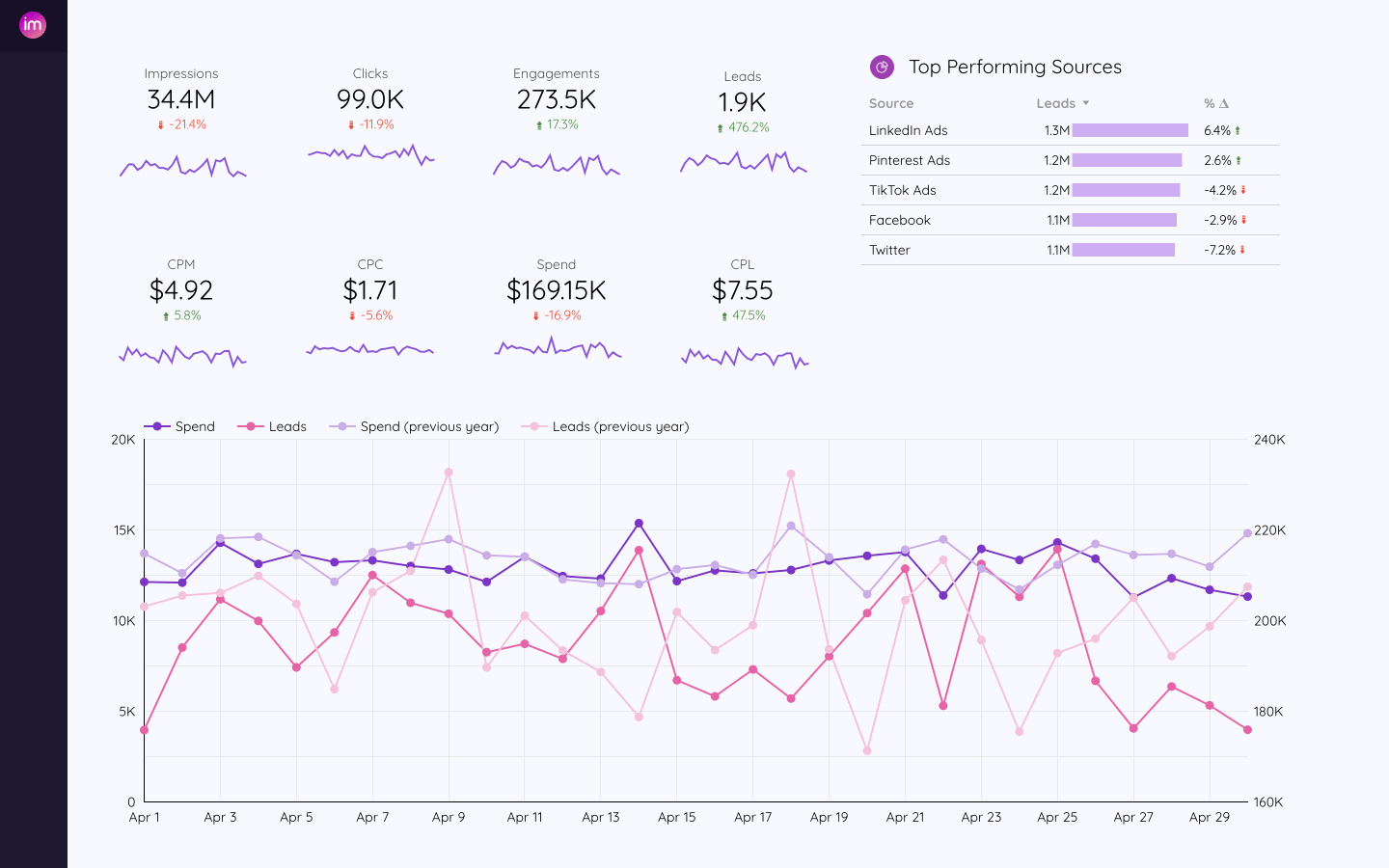 Improvado is an end-to-end data pipeline platform that gathers data from marketing platforms, MarTech tools, and CRMs, transforms this data, and ships it to various destinations.
Improvado is an end-to-end data pipeline platform that gathers data from marketing platforms, MarTech tools, and CRMs, transforms this data, and ships it to various destinations.
You can integrate with over 500 channels and harmonize and clean your data into an unified dataset.
You can then push this cleaned data to visualization tools, data warehouses, and spreadsheets. You can also keep your data in a fully-managed storage.
Similar to Supermetrics and other ETL tools, you’ll still need to move your data from Improvado to a third-party tool like Looker Studio to visualize it.
However, Improvado does offer pre-built dashboards that you can use right away with your visualization tool of your choice. This means you won’t need to spend too much time creating dashboards and reports.
But it can take months to implement Improvado and you’ll need to have strong coding skills to build dashboards. This makes it a more suitable tool for enterprises who need a powerful data analytics platform, but it may be overkill for marketing agencies and small businesses.
Improvado Reviews from Real Users
“There are a lot of ETL tools and a growing amount of AI companies, but Improvado's customer relationships and willingness to go above and beyond really sets them apart.” (Source)
“The best aspect of Improvado is their extensive range of integrations across major social, search, and ad-server platforms.” (Source)
“Improvado can be expensive, particularly for smaller businesses or startups with limited budgets.” (Source)
Key Features
- 500+ integrations
- Fully-managed data storage
- Unlimited data destinations
- Pre-built dashboards
- AI-driven data transformations
- Marketing attribution
- AI-powered campaign governance
- AI-insights
Pros and Cons
Pros:
- Powerful data analytics
- AI-powered insights
- Helpful customer support
Cons:
- Can be expensive for small businesses and agencies
- Long implementation time
- Steep learning curve
Improvado Pricing
Improvado doesn’t share their pricing publicly but based on online reviews and blog articles, the total cost can be anywhere between $2,000-$5,000 per month.

WRITTEN BY
YamonYamon is a Senior Content Marketing Manager at Whatagraph. Previously a Head of Content at a marketing agency, she has led content programs for 5+ B2B SaaS companies in the span of three years. With an eye for detail and a knack for always considering context, audience, and business goals to guide the narrative, she's on a mission to create genuinely helpful content for marketers. When she’s not working, she’s hiking, meditating, or practicing yoga.